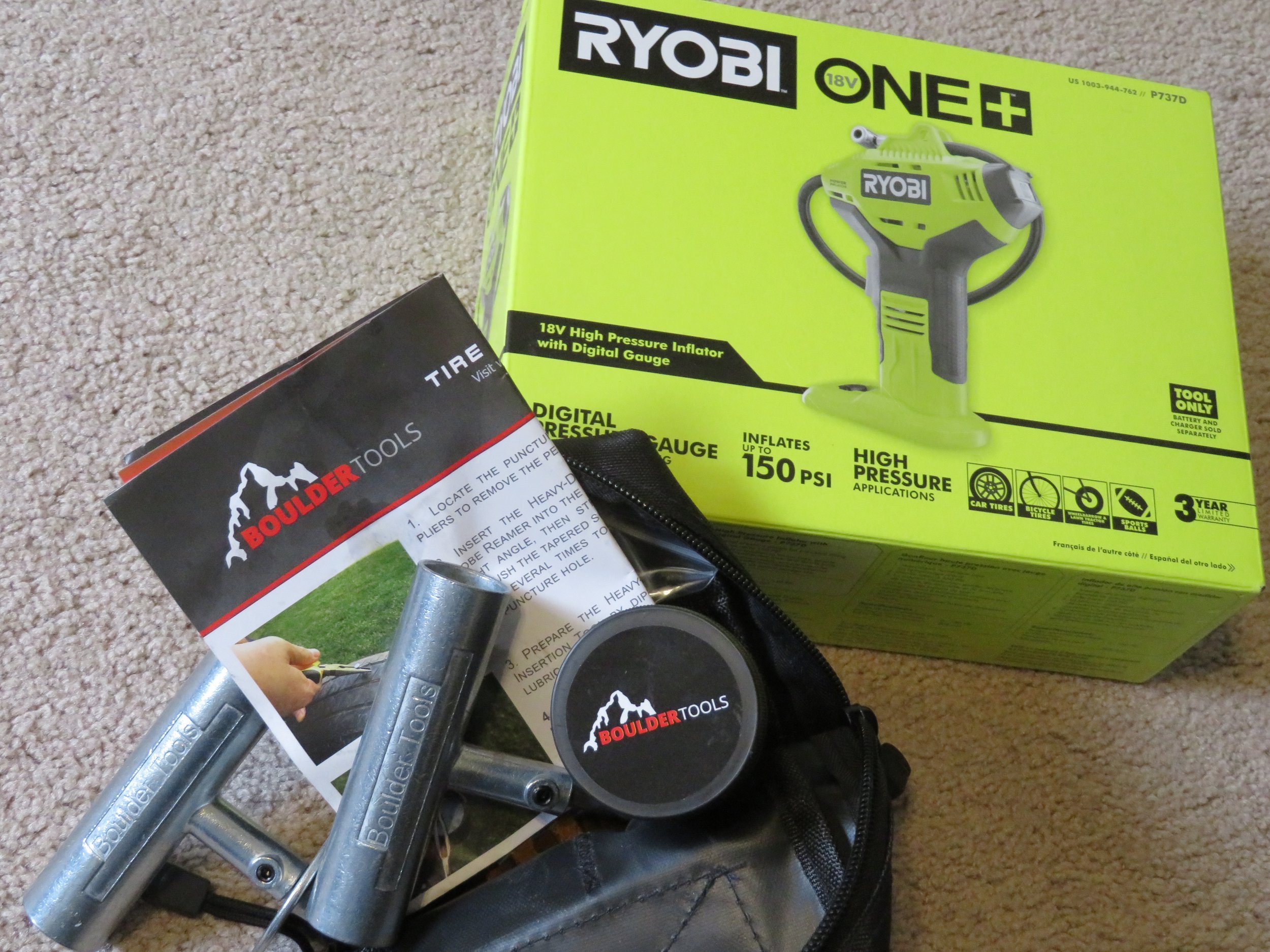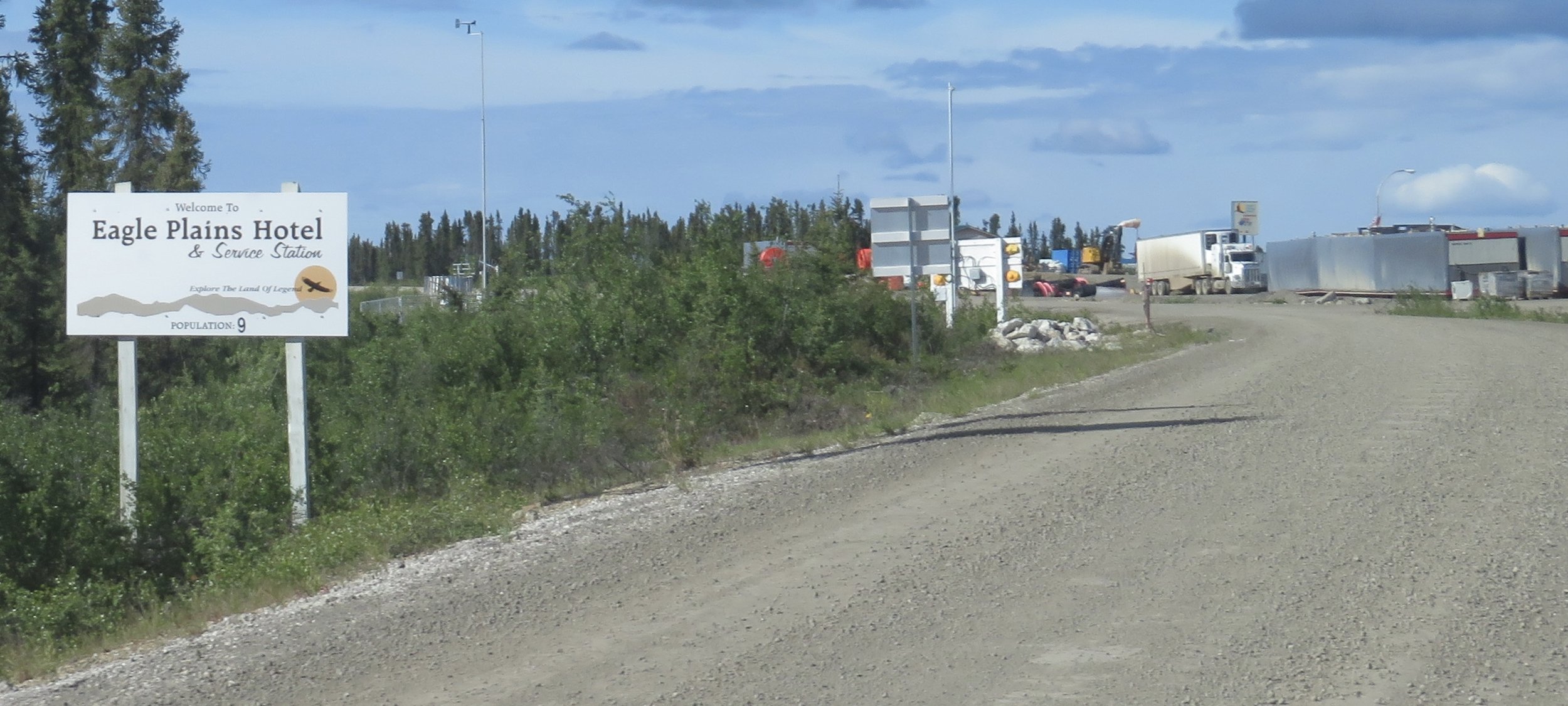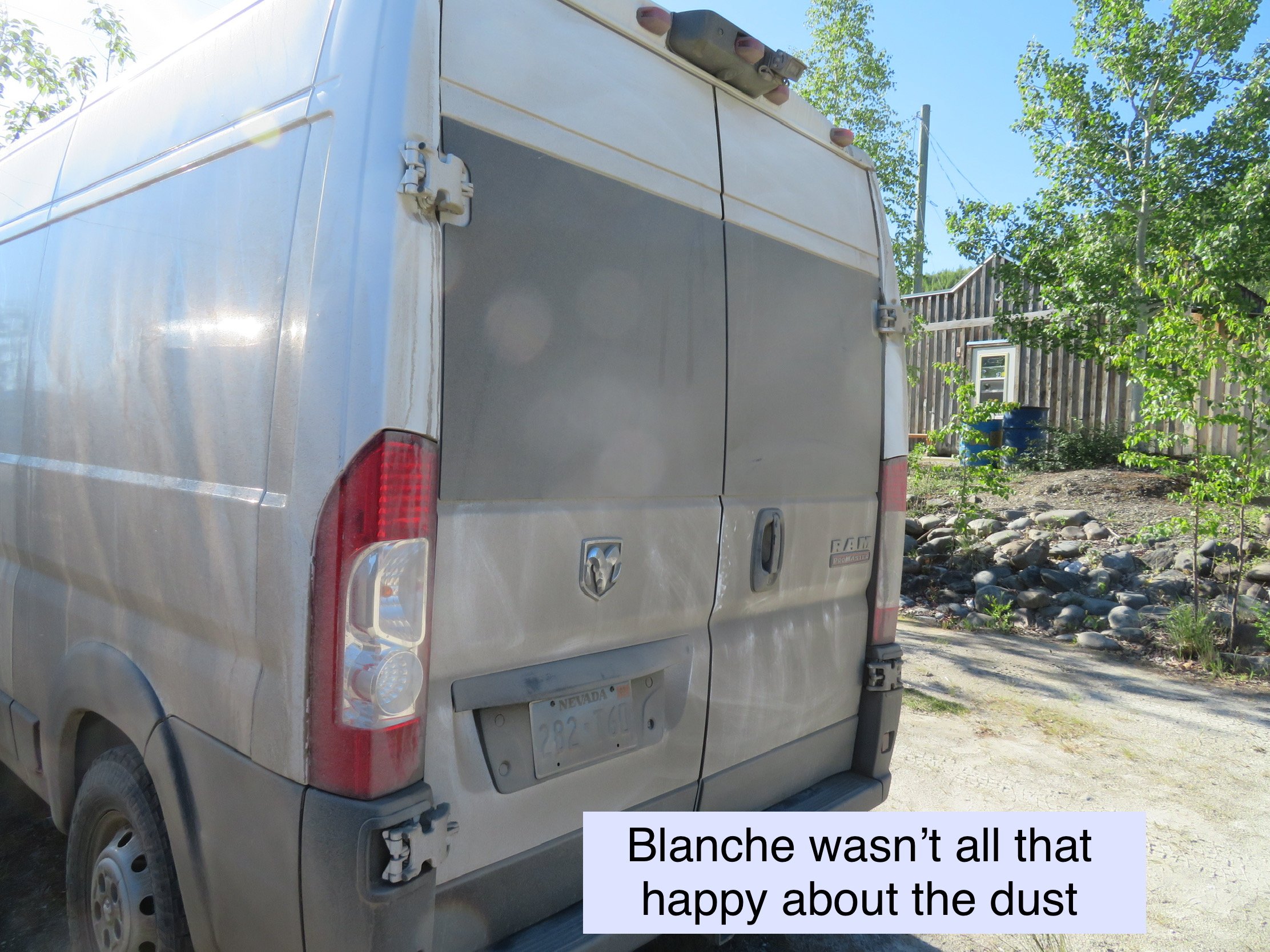12 Tips for Driving the Dempster Highway
/We did a lot of research before taking on the 575 miles of the Dempster Highway. We studied the latest edition of “the bible of North Country travel”, The Milepost. We read other blogs, both by first-timers like us as well as by old hands who had driven it countless times. As we traveled it, we talked to drivers we met along the way who had driven the road before, including several truck drivers who routinely drive it most every week of the year, and a couple who had driven it nine times in an SUV.
We made the trip in our 2019 Ram Promaster 1500. The most common vehicles we saw were pickups and pickup campers, but we also saw lots of every other type of camper… van conversions, trailers, as well as RVs much larger than our van. We also saw many regular sedans and SUVs.
Now that we’ve completed our own journey to the Arctic Ocean and back in our 2019 Ram Promaster 1500 van, we thought we’d compile and combine all that input, along with our own experience and condense it into the most important tips for driving the Dempster Highway:
#1: Preparing
There is no calling AAA here. If you have a problem, it’s quite unlikely that you’ll have cell coverage, and even if you do, the cost of having a tow truck come to the rescue will be very expensive. The most important and essential item is one, or preferably two, full size spare tires. We must have seen half a dozen people changing flats. The folks that had driven the Dempster nine times told us they had at least one flat on seven of those trips, and always carry two spares. Some new friends in a pickup camper had three flats! Along with the spare(s), we brought a tire repair kit, as well as a small, 18v battery powered tire inflator, and before we left, made sure it would inflate our rear tires to the required 80 psi. Also make sure, before you need them, that you have a jack and the right tire tools for changing a tire. In addition, we brought a windshield repair kit - broken windshields are also quite common.
#2: Road Conditions
Road conditions are constantly changing. Road crews are continually grading and repairing the road, but there are 570 miles of road to maintain, all of which see constant heavy truck traffic, frequent thunderstorms and flooding rivers.
When we drove it, the first 50 or so miles to the Tombstone campground were good, then got progressively worse to Eagle Plains. After that, the road had good and bad sections to the Yukon - Northwest Territories boundary. NWT seemed to do a better job at keeping their part of the road up.
The freshly graded sections are often as smooth as a paved road. Then there are literally hundreds of miles of washboard and sections that feel like you are driving on a cobblestone road with lots of intermittent potholes.
#3: Speed Limits
The posted speed limit is a maximum of 100 kph (~62 mph), and many people drove that speed and more. Driving that fast made us feel like our fillings would be shaken out and the van was going to come apart. In addition, I had to concentrate on avoiding the next pothole and couldn’t enjoy the spectacular scenery or watch for wildlife. We weren’t in a hurry and chose to drive at a slower speed, letting the other people pass.
BTW, if you’ve never driven on a washboard gravel road, there is usually a “sweet spot” speed where the ride is the smoothest. Driving Blanche, we found the smoothest ride at a speed of 37 to 40 miles an hour. And remember, when driving on a washboard surface, your stopping distance is much longer than on pavement - something to keep in mind before a moose or bear crosses the road in front of you.
#4: Ferries
There are two free ferry crossings on the Dempster. One crosses the Mackenzie River and the other crosses the Peel River. Be patient - oftentimes the waits for the ferries are long. In addition, the Peel cable ferry, especially, is subject to frequent closures. On the way up, we waited two hours while the cable was repaired, and on the way back down, we waited 39 hours because the river level was high (read about what we did while waiting in Marcie’s blog earlier this week).
#5: Camping and Lodging
There are several Yukon and Northwest territorial parks along the route that are more than adequate for a night’s stay. Unless the campsite is reserved in advance online, all require cash payment. Yukon territorial campgrounds (2023 prices) are $20 per night and territories are $22.50 a night. Most have free firewood, pit toilets, fire rings, picnic tables, etc. Fresh water is iffy - a few have no water and some have river water that has to be boiled before using.
Eagle Plains has a commercial campground, Fort McPherson has a municipal camping area, and Tuktoyaktuk (Tuk) has both a municipal and a commercial campground. All are pretty basic.
As for lodging, Eagle Plains has motel type rooms; Fort McPherson has a new, 4 room B&B; Inuvik has several hotel, motel and B&B options; and Tuk has two B&Bs that we are aware of.
#6: Fuel
There are only a handful of gas stations along the Dempster, so fill up when you can. We filled our tank at the station at the start of the Dempster Highway, then at Eagle Plains and Inuvik. From Inuvik, we made the 190 mile round trip to Tuk, then topped up again on our way back in Inuvik and Eagle Plains.
Not surprisingly, the price of fuel on the Dempster was higher than we’d been paying elsewhere, but it actually wasn’t as expensive as I expected. We paid between $6.00 and $6.15 USD a gallon, about 10-15 percent more than the cost of fuel in Dawson City. Of course it’s all relative… we thought the price of fuel in Dawson City was quite exorbitant.
To convert the pump price in liters to U.S. dollars per gallon, a rough approximation is to multiply the pump price by four and then multiply that by the currency exchange rate. Or, use the table below. All stations take credit cards, but not all take cash.
The Dempster is not EV friendly - we saw nary an EV charging station. 120vac, 15amp electrical outlets were available in several places, however, so if your EV has a range of at least 300 miles and you are patient enough to wait the day and a half or so to recharge at 15 amps, four times along the 1100 mile route, it can be done.
#7 Dust
Next to flat tires, the biggest annoyance while driving the Dempster, in my opinion, is dust. Fine brown dust and grit permeate and penetrate every possible surface, crook and cranny inside and outside your vehicle. It came as quite an unpleasant surprise when, after the first 250 miles or so of gravel and dirt road, we climbed into the back of Blanche to find our pillows, blankets and everything else covered in thick dust. Some vehicles did better, some did worse, but no one we talked to was immune.
After that first day, we used a tarp to cover our bed and pillows, and stowed everything else that we could inside drawers or our mule bags. Dust still found its way into the drawers, but not in the same quantities as on the exposed shelves and counters. Another thing that didn’t occur to us until the second day was to set the air vent to ‘recirculate’ to reduce the amount of dust blowing in.
We spent the better part of a day cleaning Blanche inside and out when we arrived in Dawson City.
#8: Cell Coverage and Internet
Marcie’s phone uses the Rogers networks and my prepaid Canadian SIM uses Tellus. Neither phone had any bars anywhere but in Eagle Plains, Fort McPherson, lnuvik and Tuk.
The only free wifi we could find was at the library in Inuvik, which has reasonable but limited hours. Eagle Plains has wifi for a fee.
We didn’t see anyone using Starlink, the satellite internet system, along the Dempster Highway, although the company’s website does state that it does have coverage there. We have seen a number of RVs using Starlink antennas in camping areas along the Alaska and Klondike Highways, however. Those we talked with were happy with the system. The only issue seemed to be that, since there are far fewer satellites in low-earth orbit over the far northern skies, the Starlink antenna needs an open sky, i.e., not a lot of trees overhead, to make and maintain an acceptable connection.
#9: Groceries
Both Inuvik and Tuk have reasonable grocery stores. Eagle Plains used to sell groceries, but no longer does. They do sell beer to-go in the bar. It’s a good idea to have a few extra days of food than you’re planning on, just in case there’s a road washout or ferry closure.
#10: Courtesy and safety
Some pointers regarding road safety and courtesy:
When approaching an oncoming car, slow down a little and keep as far to the right as you can to avoid getting hit with a rock… or hitting the other vehicle with one.
Despite what we read about the huge trucks hurtling past at 140 kph, throwing rocks through your windshield, we found most of truck drivers to be courteous and careful, usually slowing down as they approached. Whether they did or didn’t slow down, we did the same as for any vehicle (see above).
If someone wants to pass you, as soon as you can see enough of the road ahead to know it’s safe to do so, put on your right turn signal, slow a little and keep to the right until the vehicle passes you. Remain at the slower speed until the dust settles so you don’t have to eat dust any longer than necessary.
If someone lets you pass, turn on your flashers for a couple of seconds to say thanks.
On many of our country’s small back roads, it’s common courtesy to give a little wave to the driver of an oncoming vehicle. This was true in the rural areas of Colorado where I grew up, it’s been true on most of our travels through the north country, midwest and southwest, and it’s certainly true on the Dempster. The tourists from the cities don’t usually look at the other driver, and probably don’t know to wave, but the local drivers as well as drivers from small towns anywhere will almost always give you a wave or wave back at you. There’s no wrong way to wave, but the way my dad taught me (and the coolest method IMO) is as follows: instead of keeping your hands at 10 and 2, keep them more at about 11 and 3. You can’t always see the other driver’s face, but you can almost always see the hands, and the other driver can usually see yours. When it’s time to wave, simply raise your middle and forefinger of your left hand in sort of a ‘V’ or peace sign for a couple of seconds.
#11: Water
If you are camping, be aware that not all the campgrounds have potable water. Some have no water and some have a spigot or pump with river water, which should be boiled before using. Drinking water is available at Eagle Plains, Inuvik and Tuk.
#12: Summer versus Winter
We just assumed that summer would be the only viable season to travel the Dempster Highway, but consider this…
With summer, you get 24 hours of daylight, warm weather and lots of wildlife to see. You also get rough roads, tons of dust, road construction, unpredictable ferries, and hordes of mosquitoes.
In the winter, you’ll have smooth, snow-packed roads, ice bridges instead of ferries, no mosquitoes, far fewer people, and the northern lights. Winter also brings long, long nights, bitterly cold temperatures, and the chance to freeze to death if your vehicle breaks down or you go off the road.
The road is closed completely for three to four months each year, however. You can’t drive the road past the Peel River for about six weeks in the spring, when the river ice is too thin to drive on, but before the ice breaks up completely and the ferry can run again. Likewise, the road can’t be driven in the fall when the river starts to freeze, but before it’s frozen enough to drive across.
The truckers we talked to that drive the road summer and winter told us they prefer the winter. The roads are better, are plowed regularly and are rarely closed. There’s also not much traffic. They actually make better time during the winter.
We’ve been enjoying this trip so much, we actually talked about the possibility of coming back up here in the winter, if for no other reason than to see the northern lights. What an adventure that would be, eh? Blanche would need some winterizing to handle the cold, of course: a bigger fuel tank for the diesel heater, a plug-in engine warmer, more insulation, tire chains, and a battery warmer for the lithium ion batteries. We would also have to get lots more in the way of winter clothing - thermal underwear, lots of warm layers, heavy outer coats, hats, heavy gloves, boots, etc.
Then there’s the 3500 mile road trip through the northwestern states, British Columbia, and the Yukon Territory in the dead of winter just to get here. Putting those chains on, scraping the ice off the windshield every time we stop for more than an hour, pumping gas when it’s minus 20F, adding anti-gel to the heater’s diesel fuel…
Hmmm. Maybe we’ll just watch the video instead.


















